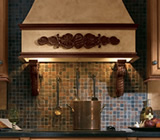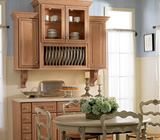 Loading... Please wait...
Loading... Please wait...Lighting
Lighting Visualizer
Lighting can have a dramatic effect on how your kitchen looks, works, and feels. Unlike most other design considerations, lighting is a dynamic element that can be adjusted to create the right atmosphere for any occasion—from dim and dramatic to bright and inviting. To get the most of your new kitchen design, be sure to include a mix of ambient, accent, and task lighting, allowing light sources to overlap.
Use our lighting visualizer below to see how the mood of a room is affected both by different types of lighting, as well as the changes in natural light over the course of the day.
Types of Lighting |
|
 |
Task LightingAnywhere you do close-up work, you’ll want task lighting: Above the counters where you slice vegetables, over the sink, stove, desk area or kitchen island. Recessed and track lighting are popular choices for direct lighting over kitchen task areas. Or mount fluorescent fixtures underneath wall cabinets to eliminate shadows and illuminate your countertops. |
 |
Accent LightingAccent lighting is used to highlight design features in your kitchen and to create a mood. You can install lighting inside a glass door cabinet to showcase its contents. Use spotlights to show off decorative accents, collectibles, or to create a dramatic focal point. Strip lights in open soffit areas draw the eye upward to help make the ceiling appear higher. |
 |
Ambient LightingAmbient light is the all-purpose lighting that generally fills a room. During the day, ambient light may come from windows, but in the evening, ceiling fixtures are the most common choice for kitchens. Different kinds of bulbs will cast a different light on your room, so be sure to consider the amount and type of light you prefer, as well as energy efficiency, when selecting ambient fixtures. |
|
OTHER DESIGN CONSIDERATIONS: Countertops Flooring Get inspiration and ideas with Room Photos in the Photo Gallery. |
|
